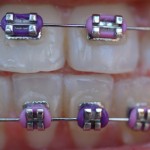
This new Cochrane review compares methods of fixing tubes on back (molar) teeth to allow the wires need to move the teeth pass through them. These can be welded to bands cemented to teeth or glued (bonded) directly to the teeth. They only found two well designed trials which suggest that bonded molar tubes are associated with a higher failure rate than with molar bands.
The majority of orthodontic treatment is carried out for children aged 10 to 14 years and is primarily concerned with correcting severe crowding and rotations, buried teeth or very prominent teeth. At age 12, 35% were judged to have an orthodontic treatment need in the UK. Fixed appliances (commonly referred to as ‘train tracks’) produce better outcomes and are favoured by orthodontists.
The success of dental braces depends partly on the metal attachments (brackets and bands) being glued to the teeth so that they do not become detached during treatment. Brackets (metal squares) are usually attached to teeth other than molars, where bands (metal rings that go round each tooth) are more commonly used. Orthodontic tubes (stainless steel tubes that allow wires to pass through them), are typically welded to bands but they may also be glued directly (bonded) to molars. Failure of brackets, bands and bonded molar tubes slows down the progress of treatment with a dental brace. In the USA there has been a doubling in the use of bonding in the last 6 years.
The review set out to address two issues:
- How often the tubes (or bands) come off during treatment
- Whether they protect the bonded (or banded) teeth against decay.
Only two trials with low risk of bias could be included and the authors concluded:
that the failure of molar tubes bonded with either a chemically-cured or light-cured adhesive was considerably higher than that of molar bands cemented with glass ionomer cement. One trial indicated that there was less decalcification with molar bands cemented with glass ionomer cement than with bonded molar tubes cemented with a light-cured adhesive. However, given there are limited data for this outcome, further evidence is required to draw more robust conclusions.
Millett DT, Mandall NA, Mattick RCR, Hickman J, Glenny AM. Adhesives for bonded molar tubes during fixed brace treatment. Cochrane Database of Systematic Reviews 2011, Issue 6. Art. No.: CD008236. DOI: 10.1002/14651858.CD008236.pub2.

[…] […]
I do not have molar band on the back of my teeth nor do I have brackets there. I only have braces on the front of my teeth. Will the straightening works without it?